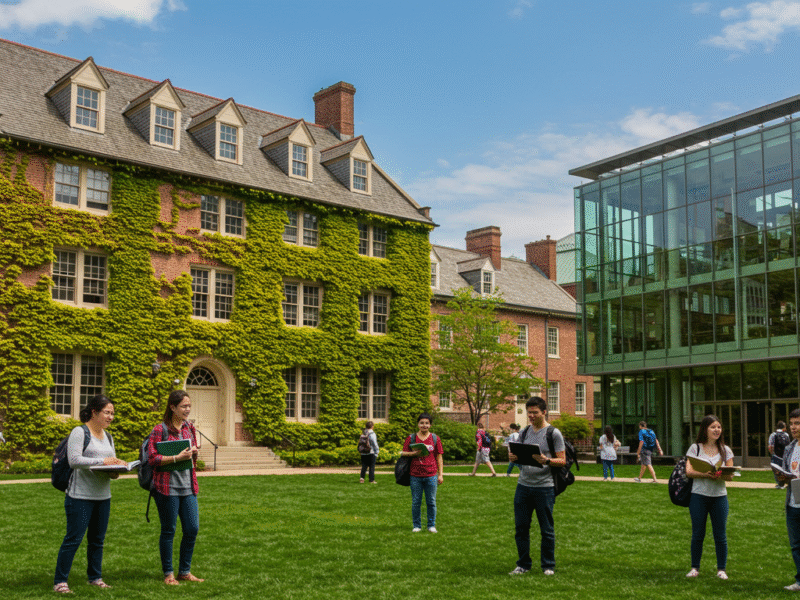Picture yourself strolling through historic campuses where ivy climbs centuries-old buildings, and the air buzzes with the ambition of future world leaders. The Ivy League universities in the USA represent the pinnacle of academic prestige, blending tradition with cutting-edge education to shape the brightest minds. These eight elite institutions—Harvard, Yale, Princeton, Columbia, Penn, Brown, Dartmouth, and Cornell—are more than just schools; they’re gateways to unparalleled opportunities. In this guide, we’ll explore what makes these universities stand out, their unique strengths, admission tips, and why they’re worth considering for your academic journey in 2025.
Why Choose an Ivy League University?
Ivy League schools are synonymous with excellence, and for good reason. They consistently rank among the world’s best, offering top-tier education, influential alumni networks, and access to resources that can catapult your career. Whether you’re aiming for a degree in business, law, medicine, or the arts, these universities provide a launchpad to global success. Their prestige carries weight with employers, with graduates often landing high-paying roles at companies like Goldman Sachs, Google, or McKinsey.
What sets the Ivies apart? For starters, their faculty includes Nobel laureates and industry pioneers who mentor students directly. Small class sizes—often with student-faculty ratios as low as 7:1—mean personalized attention. Campuses boast state-of-the-art facilities, from research labs to world-class libraries. Plus, the diversity of students from over 100 countries fosters a global perspective that’s invaluable in today’s interconnected world.
Another draw is the financial aid. Despite high tuition (often $60,000-$80,000/year), Ivies like Harvard and Princeton offer need-based aid, covering full costs for families earning under $75,000 annually. This makes them accessible to talented students regardless of background. Career outcomes are stellar—graduates see salary boosts of 60-100% within years, with many becoming CEOs, policymakers, or innovators. If you’re looking for a transformative education with lifelong benefits, the Ivy League is hard to beat.
Read Also:
How We Rank the Best Ivy League Universities
Ranking Ivy League schools isn’t just about prestige; it’s about measurable factors like academic quality, employability, and student satisfaction. Major publications like U.S. News & World Report, QS World University Rankings, and Forbes evaluate these schools based on criteria such as:
- Academic Reputation: Peer reviews from scholars and employers.
- Employability: Post-graduation salaries and job placement rates.
- Selectivity: Acceptance rates and applicant quality.
- Research Output: Publications and innovation impact.
- Student Experience: Campus facilities, diversity, and extracurriculars.
For 2025, U.S. News emphasizes graduation rates and faculty resources, while Forbes focuses on ROI and alumni success. QS highlights global reputation and research. Each Ivy excels in different areas, so we’ll dive into their unique strengths to help you find the best fit. Rankings aren’t everything—your goals and personality matter—but they’re a solid starting point.
The Ivy League Universities: A Deep Dive
Let’s explore the eight Ivy League schools, their standout programs, and what makes them special. Based on 2025 rankings from U.S. News, QS, and Forbes, here’s the lowdown on each, with insights into their vibe, academics, and career prospects.
Harvard University, Massachusetts
Founded in 1636, Harvard is the gold standard of higher education, and it’s easy to see why. Located in Cambridge, Massachusetts, this Ivy League titan tops U.S. News 2025 rankings as the #3 national university, with a global QS rank of #4. Its reputation for academic rigor and influential alumni—like Barack Obama, Bill Gates, and Natalie Portman—sets it apart.
Harvard’s undergraduate programs span 50 fields, from computer science to psychology, with graduate schools like Harvard Business School and Harvard Law leading globally. The 7:1 student-faculty ratio ensures close mentorship, and over 3,700 courses offer endless exploration. Research opportunities abound, with 100+ on-campus centers tackling everything from AI to climate change.
Admissions are tough—only 3.2% of applicants get in. You’ll need stellar grades (GPA near 4.0), SAT scores above 1500, and standout essays. Tuition is $59,076, but generous aid covers full costs for many. Graduates earn median salaries of $100,000+ within a decade, with 97% employed or in grad school post-graduation.
Campus life? Vibrant. With 450+ student organizations, from debate to sustainability clubs, there’s something for everyone. The library system, the largest private collection globally, is a scholar’s dream. If you’re driven and thrive in a competitive yet collaborative environment, Harvard’s your place.
Princeton University, New Jersey
Princeton’s picturesque campus feels like a step back in time, but its academic programs are anything but old-fashioned. Ranked #1 by U.S. News in 2025, this New Jersey gem shines for its undergraduate focus and research prowess. Its 4% acceptance rate makes it ultra-selective, but the payoff is worth it.
Known for producing Rhodes Scholars and Nobel Prize winners, Princeton excels in social sciences, engineering, and public policy. The Woodrow Wilson School is a standout for aspiring policymakers. With a 5:1 student-faculty ratio, you’ll work closely with top professors. The curriculum encourages interdisciplinary study, perfect for curious minds.
Tuition is $62,400, but Princeton’s no-loan policy means need-based aid covers 100% of demonstrated need. Graduates earn $110,000 on average 10 years out, with 93% of incoming students from the top 10% of their high school class. Career services connect you to top firms like McKinsey or startups in NYC, just an hour away.
Student life blends tradition (think eating clubs) with modern perks like the Princeton Art Museum. Sustainability is big—73% of classes have under 20 students, fostering intimate learning. If you want a tight-knit community with global impact, Princeton’s your match.
Yale University, Connecticut
Yale’s Gothic spires and vibrant New Haven campus scream prestige, but it’s the “Happy Ivy” for a reason. Ranked #5 by U.S. News and #23 globally by QS in 2025, Yale balances academic intensity with a warm community. Its 4.6% acceptance rate reflects fierce competition.
Yale shines in liberal arts, with programs like Directed Studies fostering critical thinking. The Yale School of Drama and Yale Law School are world-renowned, producing stars like Meryl Streep and justices like Sonia Sotomayor. With a 6:1 student-faculty ratio, you’ll dive deep into subjects from environmental science to political theory.
Tuition is $68,000, but aid is generous—full coverage for low-income families. Grads earn $100,533 median salaries a decade out, with strong ties to NYC and Boston job markets. Yale’s global reputation opens doors in law, media, and tech.
Campus life is electric, with cultural events, a cappella groups, and secret societies adding flair. The residential college system builds lifelong bonds. If you want intellectual depth with a creative soul, Yale’s your vibe.
Columbia University, New York
In the heart of NYC, Columbia University is a hub of innovation and ambition. Ranked #12 by U.S. News and #34 globally by QS in 2025, it’s known for its Core Curriculum, a rigorous humanities foundation. The 3.85% acceptance rate makes it one of the toughest Ivies to crack.
Columbia excels in journalism, business, and international affairs, with schools like Columbia Business School and the School of International and Public Affairs leading globally. Research opportunities, like data science and urban studies, thrive in NYC’s dynamic setting. The 6:1 student-faculty ratio ensures personalized learning.
Tuition is $66,640, with robust aid packages. Graduates earn $97,000+ on average, with strong Wall Street and media connections. Alumni include Barack Obama and Warren Buffett, showcasing Columbia’s influence.
Life in Manhattan means endless networking, from Broadway to Wall Street internships. Student clubs, like those for finance or social justice, keep you engaged. If you love urban energy and interdisciplinary study, Columbia’s your spot.
University of Pennsylvania, Pennsylvania
Penn, founded by Benjamin Franklin in 1740, blends tradition with innovation in Philadelphia. Ranked #10 by U.S. News and #11 by QS in 2025, it’s a powerhouse, especially for business and medicine. The 5.7% acceptance rate reflects its selectivity.
The Wharton School, the world’s first collegiate business school, is Penn’s crown jewel, producing leaders like Elon Musk. Programs in healthcare, engineering, and social sciences are also top-tier. With a 7:1 student-faculty ratio, you’ll get hands-on guidance.
Tuition is $63,452, but aid covers full need for many. Grads earn $95,000+ median salaries, with strong ties to finance and tech. Career services connect you to firms like Deloitte or startups in Philly’s growing scene.
Campus life mixes colonial charm with urban buzz, with clubs for everything from entrepreneurship to arts. Penn’s focus on practical skills and interdisciplinary learning makes it ideal for career-driven students.
Brown University, Rhode Island
Brown’s open curriculum is a game-changer, letting you design your academic path. Ranked #9 by U.S. News in 2025, this Providence-based Ivy has a 5.65% acceptance rate, making it slightly less competitive but still elite.
Known for liberal arts and innovation, Brown excels in cognitive science and entrepreneurship. The 7:1 student-faculty ratio fosters mentorship, and research spans AI to public health. Alumni like John Krasinski and Emma Watson show its creative edge.
Tuition is $65,656, with generous aid. Grads earn $85,000+ on average, with strong placement in tech and academia. Brown’s career services emphasize personalized paths, from startups to NGOs.
Life at Brown is laid-back yet vibrant, with a focus on community and creativity. Clubs like the Brown Investment Group or sustainability initiatives thrive. If you crave academic freedom and a supportive vibe, Brown’s your fit.
Dartmouth College, New Hampshire
Tucked in Hanover’s serene woods, Dartmouth is the Ivy with a small-town heart. Ranked #18 by U.S. News in 2025, it has a 6% acceptance rate, making it a bit more accessible. Its focus on undergraduate teaching sets it apart.
Dartmouth shines in business (Tuck School), liberal arts, and medicine, with a 7:1 student-faculty ratio. Research in sustainability and global health is cutting-edge. Alumni include Mindy Kaling and Treasury Secretary Timothy Geithner.
Tuition is $67,806, with full aid for low-income students. Grads earn $90,000+ median salaries, with strong consulting and finance connections. Career services leverage Dartmouth’s tight-knit alumni network.
Campus life is outdoorsy, with skiing, hiking, and traditions like the Winter Carnival. Clubs range from debate to Outing Club adventures. If you want a close community with big impact, Dartmouth’s your place.
Cornell University, New York
Cornell, in scenic Ithaca, is the Ivy with the highest acceptance rate at 7.5%. Ranked #12 by U.S. News and #16 by QS in 2025, it’s known for practical programs like engineering, hotel administration, and agriculture.
With a 9:1 student-faculty ratio, Cornell balances research with teaching. The Dyson School of Business and College of Engineering are top-tier, producing leaders like Dr. Anthony Fauci. Eight undergraduate colleges let you tailor your path.
Tuition is $63,200, with robust aid. Grads earn $87,000+ on average, with 98% employment rates. Career services connect you to tech, finance, and hospitality industries.
Campus life is diverse, with 1,000+ clubs and a vibrant Greek scene. Ithaca’s gorges and waterfalls add charm. If you want variety and real-world focus, Cornell’s your match.
Comparing Ivy League Universities: Which Is Right for You?
Choosing an Ivy depends on your goals. Here’s a quick comparison:
| University | U.S. News 2025 Rank | Acceptance Rate | Key Strength | Median Salary (10 Years Out) |
| Harvard | 3 | 3.2% | Global Prestige | $100,000+ |
| Princeton | 1 | 4% | Undergraduate Focus | $110,000+ |
| Yale | 5 | 4.6% | Liberal Arts | $100,533 |
| Columbia | 12 | 3.85% | Urban Opportunities | $97,000+ |
| Penn | 10 | 5.7% | Business (Wharton) | $95,000+ |
| Brown | 9 | 5.65% | Open Curriculum | $85,000+ |
| Dartmouth | 18 | 6% | Community Focus | $90,000+ |
| Cornell | 12 | 7.5% | Practical Programs | $87,000+ |
- Location: Urban lovers might pick Columbia or Penn; nature buffs, Dartmouth or Cornell.
- Academics: Brown’s flexibility vs. Columbia’s structured Core.
- Career Goals: Finance? Penn or Columbia. Policy? Princeton or Harvard.
- Vibe: Yale’s warmth vs. Harvard’s intensity.
Visit campuses or attend virtual tours to feel the fit. Talk to alumni for real insights.
Admissions: How to Get Into an Ivy League School
Getting into an Ivy is tough but doable with strategy. Here’s what you need:
- Grades: Near-perfect GPA (3.8-4.0) in rigorous courses (AP/IB).
- Test Scores: SAT 1500+ or ACT 33+ (optional at some schools in 2025, but competitive scores help).
- Essays: Authentic, compelling stories via Common App. Answer “Why this school?” with specificity.
- Extracurriculars: Show leadership and impact—think founding a club, not just joining one.
- Recommendations: Strong letters from teachers or mentors who know you well.
Early Decision boosts chances but commits you. Deadlines are November for ED, January for Regular. Each school seeks unique traits—Brown values creativity, Princeton intellectual curiosity. Start early, refine your narrative, and apply to a mix of Ivies and non-Ivies for balance.
Costs, Financial Aid, and ROI
Ivy League tuition ranges from $59,000-$68,000, plus $15,000-$25,000 for living costs. But don’t panic—aid is generous. Harvard and Princeton cover 100% of need with no loans; others offer grants and scholarships. International students qualify too, though requirements vary.
ROI is strong. Grads see salary jumps of 60-100%, recouping costs in 5-10 years. For example, Wharton MBAs earn $150,000+ post-graduation. Scholarships like Yale’s merit-based awards or Cornell’s diversity grants ease the burden. Plan finances early and explore external loans if needed.
Career Prospects and Alumni Networks
Ivy League degrees open doors. 90-95% of grads are employed or in grad school within six months, with median salaries of $85,000-$110,000 a decade out. Finance, consulting, and tech are top fields, with alumni at firms like JPMorgan, BCG, and Amazon.
Alumni networks are goldmines. Harvard’s 370,000+ alums connect you globally; Penn’s Wharton network is finance royalty. Schools offer career fairs, mentorship, and job boards. Entrepreneurship is big—Brown and Cornell grads launch startups with university support.
In 2025, demand for Ivy grads remains high, especially in AI, sustainability, and policy. Your degree ensures lifelong opportunities.
Emerging Trends in Ivy League Education
Ivies are adapting to modern needs. Sustainability is huge—Harvard’s green programs and Princeton’s eco-research lead the way. AI and data science courses are expanding, with Cornell and Columbia at the forefront. Diversity efforts are growing, with more scholarships for underrepresented groups.
Post-COVID, hybrid learning options exist, though in-person is king. Study abroad and global internships are rising, reflecting the Ivies’ international focus. Expect more emphasis on ethics and social impact in curricula.
Conclusion
The Ivy League isn’t just about prestige—it’s about unlocking your potential. From Harvard’s global reach to Dartmouth’s tight-knit community, each school offers a unique path to success. With hard work and a clear plan, you can join the ranks of their illustrious alumni. Start exploring, and make your dream a reality.
For more details, check out:











